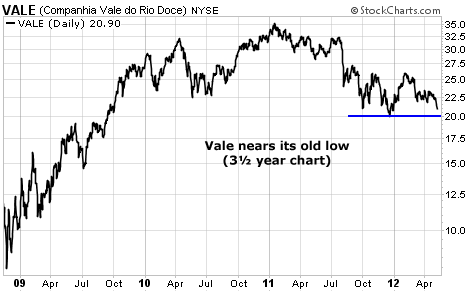| Home | About Us | Resources | Archive | Free Reports | Market Window |
How to Get a Huge Deal on Brokerage CommissionsBy
Wednesday, May 9, 2012
One of the world's greatest wealth-building strategies is now easier to take advantage of than ever.
Longtime DailyWealth readers know my favorite way to build wealth is through the power of time – what's known as compounding.
Simply stated, compound returns are money you make off the money you make. And the more money you make, the more money your money makes off the money your money makes.
I hope you're smiling, but don't dismiss the idea... As I've shown you before, the idea has incredible power. If you start with a $10,000 portfolio at age 40, you can have more than $1 million by the time you retire.
The simplest way to compound you wealth in the stock market is through reinvesting your dividends by using a dividend reinvestment plan (DRIP).
Created decades ago as a way around expensive brokerage commissions, DRIPs allow individuals to buy into companies without going through traditional Wall Street firms.
At the time, this represented a huge benefit to the investor... In the 1960s and '70s, commissions represented a significant cost and made small purchases prohibitively expensive... A 10-share stock purchase (for a total of $300) might have another $100 commission tacked on top. The stock would have to increase a huge 33% just to cover the transaction costs.
So companies were pleased when the federal government allowed them to sell stock to individual investors through DRIPs. People could buy their shares and reinvest the dividends, even if they only had a little bit of money to start.
Here's some great news for DRIP investors...
In our research on DRIPs, we've discovered an even better, less expensive way to reinvest your dividends. Here's how things have changed for investors since these programs began...
First... most companies farm out the administration of their DRIPs to a third-party company, called a "share registry." These companies act as a transfer agent between you and the company you want to purchase shares from. Over the years, these share registries have increased their fees. In some cases, it can cost as much as $20 to set up the DRIP.
But if you already have an online brokerage account... you can automatically reinvest dividends through your existing account.
It's typically cheaper than DRIPs... And it makes tracking your positions even easier. Here's why...
With most brokers, there are no fees.
Setting it up is easy, too. Just make your initial purchase. Then you'll have the option to send the dividends to your "cash" account (your bank account) or have them reinvested.
The web pages vary among brokers in how they prompt you to select the option to reinvest dividends. If you have any trouble finding the option to reinvest your dividends, your brokerage's customer service department should be able to help over the phone.
Bottom line... for convenience and savings, don't use the old school DRIPs... Go with your online broker's reinvestment option.
Here's to our health, wealth, and a great retirement,
Dr. David Eifrig
Further Reading:
"Reinvesting your dividends is the only easy money in the stock market," Dan Ferris writes. "If you're an income-focused investor, following this strategy will make the difference between a good investment... and decades of comfortable retirement living." Learn more about how to live an income-rich retirement here.
Market NotesVALE IS GETTING CLOSE TO THE DANGER ZONE One of the world's best commodity indicators is nearing a "danger zone."
Regular readers know we like to monitor shares of Brazilian iron ore giant Vale (NYSE: VALE) to get an "instant read" on the global economy. Vale is one of the world's largest iron ore producers. Much of its output goes to China. Thus, the stock is at the end of a big set of economic dominoes...
Iron ore is a vital building ingredient. It's used to make steel, which ends up in all kinds of basic products and infrastructure. If the global economy slows, folks stop building and buying things. If folks stop building and buying things, demand for steel falls. If demand for steel falls, demand for iron ore falls. If iron ore demand falls, so does Vale's share price.
Like most assets, Vale soared off its late-2008/early-2009 credit crisis bottom. After more than tripling in value, shares moved in a sideways range. Last year's big market sell-off put a bottom on this range, at $20 per share. As you can see from today's chart, the recent weakness in Vale has taken the stock very close to its old bottom. If Vale punctures this $20 area, it's a big sign the global economy is slowing.
 |
In The Daily Crux
Recent Articles
|


